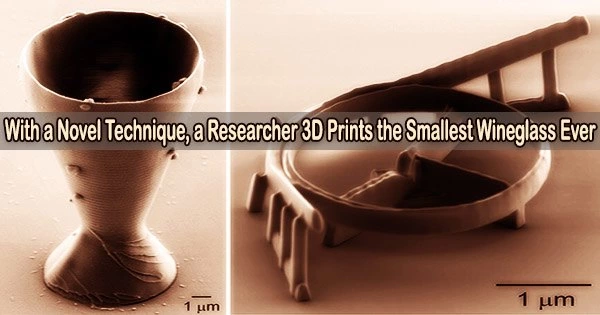The tiniest wine glass in the world, with a rim no wider than a human hair, has been 3D printed by researchers. However, the goal was not to accommodate very light drinkers. Instead, the glass was printed to show off a new, easier method for making silica glass structures for a variety of uses, from robotics to telecommunications.
“Developed” at KTH Royal Institute of Technology in Stockholm, the new technique overcomes complications, such as the need for thermal treatment, when 3D-printing essential silica glass components, says KTH Professor Frank Niklaus. The work is published in the journal Nature Communications.
According to Niklaus, some uses include filters and couplers for fiber optic networks, micro-robots that navigate harsh environments, and tailored lenses for medical equipment that performs minimally invasive surgery.
One such fiber optic filter was produced in the study. The researchers show that the technique can print devices directly on the tip of an optical fiber as thin as a strand of a human hair.
Eliminating the need for thermal treatment increases the possibility for the technique to be used widely in various application scenarios. The concerns when integrating 3D printing methods are usually different for different applications. Even though optimization of our method is still required for different applications, we believe our method presents an important and necessary breakthrough for 3D glass printing to be used in practical scenarios.
Po-Han Huang
“The backbone of the internet is based on optical fibers made of glass. In those systems, all kinds of filters and couplers are needed that can now be 3D printed by our technique,” says co-author Kristinn Gylfason, an associate professor of Micro- and Nanosystems at KTH. “This opens many new possibilities.”
“The method drastically reduces the energy needed to 3D print silica glass, which normally requires heating materials up to several hundred degrees for hours, says the study’s lead author,” Po-Han Huang, a doctoral student at KTH. “The advantage of our method is there’s no need for thermal treatment and the glass can withstand extreme heat in applications.”
He adds that the process also has the advantage of employing widely available, commercially available components to create silica glass.
“Eliminating the need for thermal treatment increases the possibility for the technique to be used widely in various application scenarios,” he says. “The concerns when integrating 3D printing methods are usually different for different applications. Even though optimization of our method is still required for different applications, we believe our method presents an important and necessary breakthrough for 3D glass printing to be used in practical scenarios.”
So what about that wineglass? Is it really the world’s smallest? After all, people have already 3D printed a lot of demonstration objects, like statues and model cars.
Niklaus says the difference is that this demo is in glass. “Definitely nobody has 3D printed a wineglass that consists of glass as-printed,” he says.
















